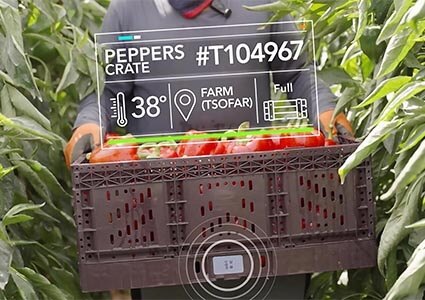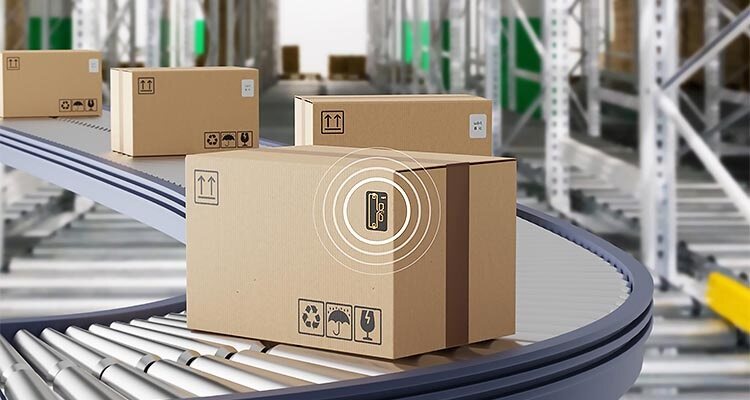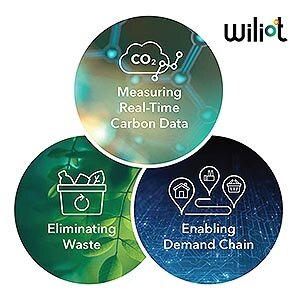Leveraging the power of ambient IoT, Wiliot is revolutionizing supply chains across various markets
As technology accelerates across the globe, startup company, Wiliot, is developing Internet of Things (IoT) technology for supply chains and asset management. Founded in 2017, the company has developed Wiliot Cloud and IoT Pixels, which have the brains and self-awareness to inform people of several insights like where things are, who is using them, and when they need replenishing.
From raincoats to eggs or even controlled substances, virtually all products across the supply chain can benefit from Wiliot’s item-level awareness. Through its breakthrough products, the business is transforming manufacturing and distribution by providing new levels of real-time awareness – and there are sustainability benefits too. 
“We’re a leader in the area of ambient IoT, which is the realization of the original IoT mission of connecting everything to the cloud but done with a new generation of technology that allows us to surpass our current limited state of IoT,” begins Steve Statler, Chief Marketing Officer. “We leverage this technology by enabling a chip, which is connected to a cloud service, and the chip powers a computer the size of a postage stamp. The chip is powered by recycling or harvesting the energy from radio waves, meaning the tracking devices or smart tags are extremely low cost.
Enhancing visibility
“We’re already manufacturing chips in their millions and most of the leading radio frequency identification (RFID) tag manufacturers are adapting their production systems for RFID tags to make our IoT Pixels. For example, Identiv, a leading manufacturer of RFID and NFC tags has been public about ramping up its operations to make millions of our ambient IoT tags. Identiv is leveraging the equipment and expertise it developed for gen2 RFID for what we see as being the next generation of radio frequency identification.
“Currently, 99.9 percent of things are offline; in the dark if you like. We’re on a mission to transform that statistic by connecting food, medicine, clothing, and so on, to address major societal issues around climate change, productivity, crime, and improving convenience by harnessing arguably one of the biggest powers in the world, internet and AI, and connecting it to the things that surround us.
“By implementing our sensors, supply chains become visible end to end, rather than just snapshots across the chain,” he says. “This opens huge opportunities to optimize both labor and efficiency. In the logistics world, there are a lot of cages, trays, and totes, which are like the white blood cells that carry oxygen through the body of the system. However, these are prime examples of things that traditionally have limited visibility, but our sensors allow them to be continuously visible in real time. Through a real-time view of yield and utilization, our sensors enable more dynamic routing of deliveries using smaller vehicles.
“Further down the line, it provides the opportunity to move from a supply chain to a demand chain, similar to the operating model used in the vending machine sector. This system shares demand signals from customers, like stock levels and data, directly with manufacturers, which has the potential to revolutionize the supply chain. By being close to customers in today’s retail model, we see a future where there’s visibility all the way downstream from the manufacturer to the end consumer, and all the way upstream from the consumer to the manufacturer.
“In recent years, we’ve seen a huge battle between stores and omnichannel retailers, and the impact this has had on the restructuring of supply chains. Retailers are demanding a more accurate view of their inventory to eliminate issues with procurement and replenishment. That’s where our tags are invaluable, as when they are placed on the product packaging, they relay important data back to manufacturers, such as how full the package is and when replenishment is required.”
 Reducing waste
Reducing waste
Through connectivity, Wiliot’s solutions also provide customers with sustainability benefits. “Environmental responsibility is a big driver for many of our projects,” Steve states. “In the retail industry, for instance, returns are an inevitable part of the operation, but one of the biggest areas of waste. A large proportion of returned items are never resold, but we’ve seen a huge reduction in this figure if our IoT Pixels are added to every item at the first stage in the returns process.
“Waste is also a pressing issue in the food industry, with shocking figures revealing that 40 percent of food is wasted before it gets to the table. Our cloud can analyze factors like temperature control and the flow of the product, which enables us to look at the entire history of the product and access full traceability of food items. At a price of just $36, ambient IoT readers are an effective and affordable way to track products at item level by placing tags in delivery vehicles.
People, planet, and profit
“Some of our early customers are the world’s largest online and grocery retailers, and we’re preparing to announce our work with a major postal carrier in the next few weeks,” he adds. “We’re also developing digital product passports in line with legislator requirements, particularly in the European Union. This provides customers with rich data to give an end-to-end view of not only where the product came from, but how it was treated.”
As our conversation draws to a close, Steve reflects on Wiliot’s recognition as a visionary in the Gartner Magic Quadrant in 2023. “As the biggest analyst organization, being recognized by Gartner is an incredible milestone for us,” he states. “We went through a very stringent process with lots of questions and details, and we’re proud to have received their ‘stamp of approval’ as it were. It’s a great start for us and I’m confident that you’ll be seeing more recognition and visibility as we continue to grow.
“In my view, any business must balance people, planet, and profit to experience true success,” Steve concludes. “By addressing these three aspects, we’re seeing things that have never been done before and continuously measuring visibility at a high level of granularity. The future will see us involved in more interesting applications, and we’re excited about the immense potential of our product across various sectors.”

 Reducing waste
Reducing waste